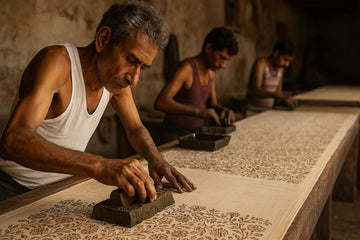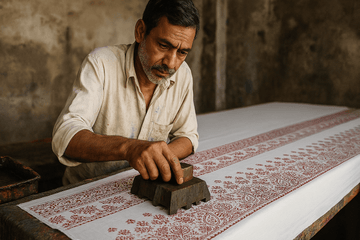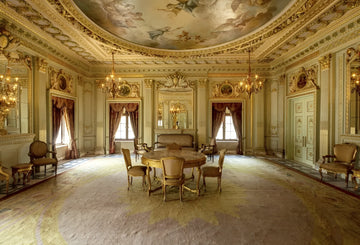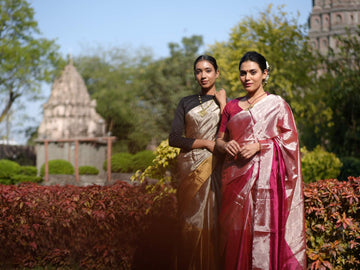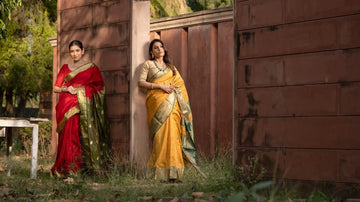
India's handloom heritage is a mesmerizing tapestry woven with threads of history, culture, and artisanal excellence. Among its many treasures, Maheshwari handloom sarees stand out for their regal elegance, intricate craftsmanship, and rich history that dates back to the 18th century. These sarees have endured the test of time, weaving their legacy through centuries of royal patronage, industrialization, and changing fashion trends. In this blog, we delve deep into the origins, evolution, impact, and types of Maheshwari handloom sarees.
The Origin Story of Maheshwari Handloom Sarees
Maheshwari sarees originate from Maheshwar, a historic town on the banks of the Narmada River in Madhya Pradesh. This weaving tradition owes its birth to Queen Ahilyabai Holkar, the revered ruler of the Malwa region in the 18th century. It is believed that she commissioned the first Maheshwari sarees to be crafted for royal guests visting Maheshwar around year 1770. The sarees were initially meant for royalty, characterized by their exquisite craftsmanship and luxurious appeal.
Inspired by the architectural grandeur of Maheshwar Fort, the saree’s designs replicate intricate motifs like chatai (woven mat patterns), eent (brick patterns), heera (diamond shapes), and leheriya (waves). Over time, this once-exclusive fabric found its way to the wider public, establishing itself as a symbol of refined taste and understated elegance.
The Ups and Downs: A Journey of Resilience
Like many Indian handloom traditions, Maheshwari weaving has experienced its fair share of highs and lows. During the British era, industrialization and machine-made textiles posed a serious threat to handloom industries. However, local weavers, backed by royal patronage, managed to sustain the craft.
Post-independence, changing fashion trends and the lure of power loom textiles led to a decline in demand. Many weavers switched professions due to financial instability. However, in recent decades, efforts by government initiatives, cooperatives, and private enterprises have revived interest in Maheshwari sarees. The growing appreciation for sustainable fashion and handmade textiles has further contributed to their resurgence in both domestic and international markets.
The Social Impact of Maheshwari Weaving
Beyond being a luxurious fabric, Maheshwari handloom weaving has played a crucial role in social and economic empowerment, particularly for women. The craft provides employment to numerous weavers, artisans, and dyers in Maheshwar and surrounding regions. Many NGOs and government-backed programs have worked to support weavers, ensuring fair wages and better working conditions.
Additionally, Maheshwari sarees align with the global movement towards ethical fashion. Unlike synthetic, machine-made fabrics, these sarees are crafted with minimal environmental impact, using natural fibers and traditional dyeing techniques. When you buy a Maheshwari saree, you are not just purchasing a garment; you are supporting a sustainable livelihood and keeping an ancient art form alive.
Types of Maheshwari Handloom Sarees Based on Fabric
Maheshwari sarees are known for their lightweight texture, fine weave, and reversible borders (also known as bugdi). The fabric used in these sarees can be classified into different types based on the blend of yarns:
1. Pure Cotton Maheshwari Handloom Sarees
-
Made from 100% cotton yarn, these sarees are ideal for summer wear.
-
Breathable, lightweight, and comfortable, they are perfect for both casual and formal occasions.
-
Typically adorned with subtle zari work and intricate border designs.
- Warp - Cotton, Weft - Cotton
2. Silk by Cotton Maheshwari Handloom Sarees
-
A balanced blend of silk and cotton, offering the sheen of silk and the comfort of cotton.
-
Suitable for semi-formal occasions and office wear.
-
The fabric drapes beautifully, giving the wearer an elegant look.
- Warp - Silk, Weft - Cotton
3. Pure Mulberry Silk Maheshwari Handloom Sarees
-
Made entirely of fine silk threads, these sarees exude luxury and grace.
-
Ideal for festive occasions, weddings, and grand celebrations.
-
Often feature intricate zari work with vibrant colors and rich motifs.
- Warp - Silk, Weft - Silk
4. Tissue Silk Maheshwari Handloom Sarees
-
Crafted with silk threads woven to create a slightly translucent, shimmering texture.
-
These sarees have a lightweight, gossamer-like appearance, making them perfect for evening events and parties.
-
Usually adorned with delicate zari buti (small motifs) and grand pallus.
- Warp - Silk & zari, Weft - Cotton & zari
Design Patterns in Maheshwari Sarees
One of the most distinctive features of Maheshwari sarees is their elegant and minimalistic design, which is heavily inspired by architectural elements of Maheshwar. Some of the most popular design patterns include:
-
Chatai (Mat Pattern): A geometric weave reminiscent of woven mats.
-
Eent (Brick Pattern): A solid, structured design resembling bricks from historical structures.
-
Heera (Diamond Motif): A classic diamond-shaped pattern symbolizing prosperity and grace.
-
Leheriya (Wave Motif) aka Narmada Lehar: Inspired by the waves of the Narmada River, this pattern reflects movement and fluidity. This is one of the most common border designs in Maheshwari handloom sarees!
-
Phool (Floral Motifs): Subtle floral patterns adding a touch of nature to the weave.
These intricate patterns are often woven in gold and silver zari, lending a touch of regal elegance to the fabric.
The Timeless Allure of Maheshwari Sarees
A Maheshwari saree is more than just a drape; it is a legacy. Every thread tells a story of artisanship, resilience, and timeless beauty. Whether you are a lover of handloom weaves or a conscious fashion enthusiast, owning a Maheshwari saree is like possessing a piece of history that continues to evolve while staying rooted in tradition.
As we move towards a future that values sustainable fashion and cultural heritage, Maheshwari sarees continue to shine as an epitome of elegance, grace, and ethical craftsmanship. So, the next time you drape a Maheshwari saree, know that you are not just wearing fabric—you are embracing centuries of artistry, history, and heritage.
A Tribute to the Visionaries Who Kept the Legacy Alive
The story of Maheshwari sarees would be incomplete without honoring the visionaries who safeguarded this heritage. It was Maa Ahilya Bai Holkar, the revered queen of Malwa, who first breathed life into this exquisite weave, commissioning artisans to craft sarees that reflected the architectural splendor of Maheshwar. Her patronage laid the foundation for a weaving tradition that still thrives today.
In more recent times, Richard Holkar and Sally Holkar, descendants of the Holkar dynasty, played a crucial role in reviving Maheshwari handloom sarees. With their deep commitment to sustainability and rural empowerment, they co-founded the Rehwa Society, a non-profit organization dedicated to supporting weavers, especially women. Thanks to their efforts, hundreds of families in Maheshwar continue to weave magic, preserving this art form while earning a dignified livelihood.


